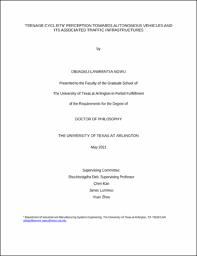
ATTENTION: The works hosted here are being migrated to a new repository that will consolidate resources, improve discoverability, and better show UTA's research impact on the global community. We will update authors as the migration progresses. Please see MavMatrix for more information.
Show simple item record
| dc.contributor.advisor | Deb, Shuchisnigdha | |
| dc.creator | Ngwu, Obiageli Lawrentia | |
| dc.date.accessioned | 2021-06-01T20:38:35Z | |
| dc.date.available | 2021-06-01T20:38:35Z | |
| dc.date.created | 2021-05 | |
| dc.date.issued | 2021-05-03 | |
| dc.date.submitted | May 2021 | |
| dc.identifier.uri | http://hdl.handle.net/10106/29812 | |
| dc.description.abstract | Background: Cycling is a cost-effective means of transportation. Many teenagers cycle to go to schools and ride in neighborhoods. Cyclists are more vulnerable to injuries and fatalities than motor vehicle drivers. With the implementation of autonomous vehicles (AVs), interactions between AVs and road-users are expected to be safer. It is most likely that current young people will be the ones to use these vehicles and interact with them. However, very few past studies have focused on cyclist-AV interaction, with little to no attention toward the teenage cyclist population.
Objectives: This study is aimed at examining teenage cyclists’ perceptions of AVs and identifying supporting infrastructures or communication interfaces necessary for them to interact with AVs.
Methodology: A virtual focus group study with 20 participants (12 females aged 13-17-years) was conducted in four groups. Each group had three to five participants attending a one-hour session and were presented with simulated pictures of potential designs for infrastructures and interfaces. Participants rated the designs and answered multiple surveys to express their cycling behavior, perceptions toward AVs, and expected infrastructures and modes for cyclist-AV interaction.
Results: Teenage cyclists were receptive towards AVs and believed that AVs would be safer. However, they would like to have more spacious lanes for cyclists and physical barriers separating AVs and cyclists. They preferred visual interfaces with familiar icons to be more effective for interfaces; nevertheless, they recommended both visual and audible interfaces to ensure cyclists’ attention and include the need of visually and audibly impaired populations.
Conclusions: Future researchers and stakeholders will be benefited from the methodology and outcomes of this research. Further research can test these designs in a simulated environments or real-world environments to get realistic responses from cyclists and for the establishment of universal designs. | |
| dc.format.mimetype | application/pdf | |
| dc.language.iso | en_US | |
| dc.subject | Autonomous vehicles | |
| dc.subject | Cyclists | |
| dc.subject | Perception | |
| dc.subject | Traffic | |
| dc.subject | Infrastructures | |
| dc.subject | Conventional vehicles | |
| dc.subject | Potential designs | |
| dc.subject | Interacting signals | |
| dc.title | TEENAGE CYCLISTS’ PERCEPTION TOWARDS AUTONOMOUS VEHICLES AND ITS ASSOCIATED TRAFFIC INFRASTRUCTURES | |
| dc.type | Thesis | |
| dc.contributor.committeeMember | Zhou, Yuan | |
| dc.degree.department | Industrial and Manufacturing Systems Engineering | |
| dc.degree.name | Doctor of Philosophy in Industrial Engineering | |
| dc.date.updated | 2021-06-01T20:38:36Z | |
| thesis.degree.department | Industrial and Manufacturing Systems Engineering | |
| thesis.degree.grantor | The University of Texas at Arlington | |
| thesis.degree.level | Doctoral | |
| thesis.degree.name | Doctor of Philosophy in Industrial Engineering | |
| dc.type.material | text | |
| dc.creator.orcid | 0000-0002-4934-5275 | |
Files in this item
- Name:
- NGWU-DISSERTATION-2021.pdf
- Size:
- 856.1Kb
- Format:
- PDF
This item appears in the following Collection(s)
Show simple item record


